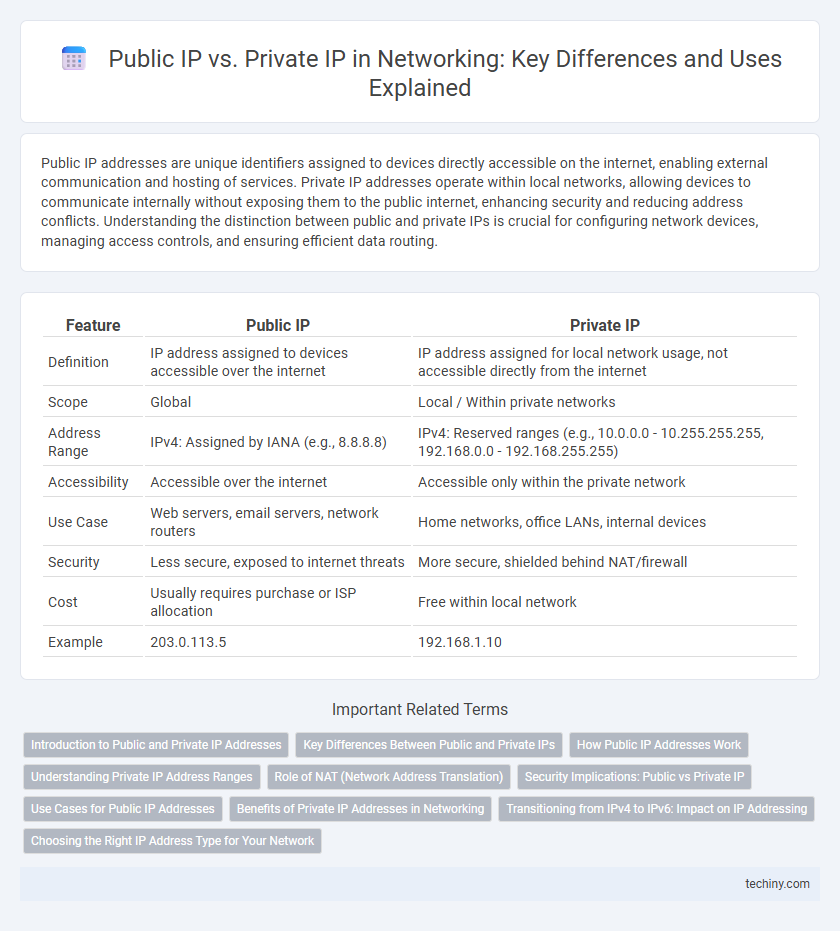Public IP addresses are unique identifiers assigned to devices directly accessible on the internet, enabling external communication and hosting of services. Private IP addresses operate within local networks, allowing devices to communicate internally without exposing them to the public internet, enhancing security and reducing address conflicts. Understanding the distinction between public and private IPs is crucial for configuring network devices, managing access controls, and ensuring efficient data routing.
Table of Comparison
| Feature | Public IP | Private IP |
|---|---|---|
| Definition | IP address assigned to devices accessible over the internet | IP address assigned for local network usage, not accessible directly from the internet |
| Scope | Global | Local / Within private networks |
| Address Range | IPv4: Assigned by IANA (e.g., 8.8.8.8) | IPv4: Reserved ranges (e.g., 10.0.0.0 - 10.255.255.255, 192.168.0.0 - 192.168.255.255) |
| Accessibility | Accessible over the internet | Accessible only within the private network |
| Use Case | Web servers, email servers, network routers | Home networks, office LANs, internal devices |
| Security | Less secure, exposed to internet threats | More secure, shielded behind NAT/firewall |
| Cost | Usually requires purchase or ISP allocation | Free within local network |
| Example | 203.0.113.5 | 192.168.1.10 |
Introduction to Public and Private IP Addresses
Public IP addresses are unique identifiers assigned to devices on the global internet, allowing direct access and communication across networks. Private IP addresses are reserved for local networks, enabling devices within a specific area like a home or office to connect securely without direct exposure to the internet. Both address types follow IPv4 or IPv6 standards, essential for routing and network management.
Key Differences Between Public and Private IPs
Public IP addresses are globally unique and assigned by Internet Service Providers (ISPs) for devices to communicate over the internet, while private IP addresses are reserved for internal network use and defined by IPv4 ranges such as 10.0.0.0/8, 172.16.0.0/12, and 192.168.0.0/16. Public IPs enable external connectivity but face higher security risks, whereas private IPs enhance security by restricting access within a local network and require Network Address Translation (NAT) to connect to the internet. The distinction is essential for network configuration, resource allocation, and maintaining efficient and secure communication channels.
How Public IP Addresses Work
Public IP addresses are unique identifiers assigned to devices on the global internet, enabling direct communication across different networks. They are allocated by Internet Service Providers (ISPs) and governed by regional Internet registries to ensure global uniqueness. Devices with public IPs can be accessed from anywhere on the internet, facilitating services like web hosting, email, and VPN connections.
Understanding Private IP Address Ranges
Private IP address ranges are designated blocks of IP addresses reserved for use within private networks, ensuring devices can communicate internally without exposure to the public internet. These ranges include 10.0.0.0 to 10.255.255.255 (Class A), 172.16.0.0 to 172.31.255.255 (Class B), and 192.168.0.0 to 192.168.255.255 (Class C), as defined by RFC 1918 standards. Understanding these blocks is crucial for network design, enabling efficient IP allocation while maintaining security and avoiding address conflicts with Public IP addresses.
Role of NAT (Network Address Translation)
Network Address Translation (NAT) serves as a critical bridge between public IP addresses and private IP addresses by enabling devices within a local network to communicate with external networks using a single public IP. NAT translates private IP addresses to a public IP address for outbound traffic, conserving the limited pool of public IPs and enhancing network security by masking internal IP structures. This mechanism is essential for routing traffic efficiently, managing IP address allocation, and protecting internal network topology from exposure on the internet.
Security Implications: Public vs Private IP
Public IP addresses expose devices directly to the internet, increasing vulnerability to cyberattacks such as DDoS, hacking, and unauthorized access. Private IP addresses operate within local networks, providing inherent security by isolating devices from external threats and reducing the attack surface. Network Address Translation (NAT) further protects private IP devices by masking internal IP addresses behind a single public IP, enhancing overall network security.
Use Cases for Public IP Addresses
Public IP addresses are essential for identifying devices on the global internet, enabling direct communication and accessibility across networks. They are commonly assigned to servers hosting websites, email, and cloud services to ensure these resources are reachable worldwide. Internet Service Providers (ISPs) allocate these unique IPs to connect businesses, data centers, and individual users to public networks with consistent identification.
Benefits of Private IP Addresses in Networking
Private IP addresses enhance network security by isolating internal systems from external threats, reducing the attack surface. They enable efficient IP address management within organizations by allowing multiple devices to share a limited pool of IPs without public exposure. Utilizing private IPs also improves network performance by minimizing unnecessary traffic on the public internet, facilitating faster and more reliable communication within local networks.
Transitioning from IPv4 to IPv6: Impact on IP Addressing
Transitioning from IPv4 to IPv6 addresses the limitations of IPv4 public and private IP spaces by expanding the address pool from 32 bits to 128 bits, enabling a vastly larger number of unique IP addresses. IPv6 eliminates the need for NAT (Network Address Translation) typically used in private IPv4 networks by providing globally routable addresses to all devices, enhancing end-to-end connectivity. This shift supports better scalability, more efficient routing, and improved security protocols embedded in the IPv6 header structure.
Choosing the Right IP Address Type for Your Network
Choosing the right IP address type for your network depends on security, accessibility, and scalability requirements. Public IP addresses allow devices to communicate over the internet, providing global reach but exposing them to external threats. Private IP addresses are confined to local networks, enhancing security and conserving public IP resources by enabling devices to communicate internally without direct internet exposure.
Public IP vs Private IP Infographic

 techiny.com
techiny.com